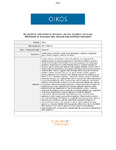Do positive interactions between marine invaders increase likelihood of invasion into natural and artificial habitats?
| dc.contributor.author | Firth, Louise | |
| dc.contributor.author | Duff, L | |
| dc.contributor.author | Gribben, PE | |
| dc.contributor.author | Knights, Antony | |
| dc.date.accessioned | 2021-02-01T17:51:21Z | |
| dc.date.available | 2021-02-01T17:51:21Z | |
| dc.date.issued | 2020-12-24 | |
| dc.identifier.issn | 0030-1299 | |
| dc.identifier.issn | 1600-0706 | |
| dc.identifier.other | oik.07862 | |
| dc.identifier.uri | http://hdl.handle.net/10026.1/16835 | |
| dc.description.abstract |
<jats:p>Positive species interactions such as facilitation are important for enabling species to persist, especially in stressful conditions, and the nature and strength of facilitation varies along physical and biological gradients. Expansion of coastal infrastructure is creating hotspots of invasive species which can spillover into natural habitats, but the role of positive species interactions associated with biological invasions remains understudied. Theory suggests that stronger biotic pressure in natural habitats inhibits invasion success. In space‐limited marine systems, sessile organisms can overcome this limiting resource by settling as an epibiont on a substrate organism – basibiont. Using a series of spatially extensive surveys, we explored the role of invasive and native basibionts in providing habitat for other invasive and native epibionts, and tested whether environmental context (i.e. if the receiving habitat was natural or artificial), altered ecological outcomes. Overall, provision of space by basibionts was more important for invasive epibionts than for native epibionts but was dependent on the environmental context. Invasive basibionts facilitated invasive epibionts in natural habitats, and appeared to be more important for native epibionts in artificial habitats respectively. Native basibionts facilitated invasive, but not native epibionts in both natural and artificial habitats. These results advance our understanding of facilitation and highlight the idiosyncratic nature of biofouling and epibiosis, and the potentially important influence of environmental context. The degree to which native habitat‐forming species versus invasive habitat‐forming species either do or do not facilitate other native or non‐native species is a rich area for investigation. Experimental work is required to disentangle the processes underpinning these patterns.</jats:p> | |
| dc.format.extent | 453-463 | |
| dc.language | en | |
| dc.language.iso | en | |
| dc.publisher | Wiley | |
| dc.subject | artificial structure | |
| dc.subject | Austrominius modestus | |
| dc.subject | biotic homogenisation | |
| dc.subject | epibiosis | |
| dc.subject | Magallana gigas | |
| dc.subject | oyster | |
| dc.subject | Patella vulgata | |
| dc.title | Do positive interactions between marine invaders increase likelihood of invasion into natural and artificial habitats? | |
| dc.type | journal-article | |
| dc.type | Journal Article | |
| plymouth.author-url | https://www.webofscience.com/api/gateway?GWVersion=2&SrcApp=PARTNER_APP&SrcAuth=LinksAMR&KeyUT=WOS:000601347400001&DestLinkType=FullRecord&DestApp=ALL_WOS&UsrCustomerID=11bb513d99f797142bcfeffcc58ea008 | |
| plymouth.issue | 3 | |
| plymouth.volume | 130 | |
| plymouth.publisher-url | https://onlinelibrary.wiley.com/doi/full/10.1111/oik.07862 | |
| plymouth.publication-status | Published | |
| plymouth.journal | Oikos | |
| dc.identifier.doi | 10.1111/oik.07862 | |
| plymouth.organisational-group | /Plymouth | |
| plymouth.organisational-group | /Plymouth/Faculty of Science and Engineering | |
| plymouth.organisational-group | /Plymouth/Faculty of Science and Engineering/School of Biological and Marine Sciences | |
| plymouth.organisational-group | /Plymouth/REF 2021 Researchers by UoA | |
| plymouth.organisational-group | /Plymouth/REF 2021 Researchers by UoA/UoA07 Earth Systems and Environmental Sciences | |
| plymouth.organisational-group | /Plymouth/Users by role | |
| plymouth.organisational-group | /Plymouth/Users by role/Academics | |
| plymouth.organisational-group | /Plymouth/Users by role/Researchers in ResearchFish submission | |
| dcterms.dateAccepted | 2020-12-02 | |
| dc.rights.embargodate | 2021-12-24 | |
| dc.identifier.eissn | 1600-0706 | |
| dc.rights.embargoperiod | Not known | |
| rioxxterms.versionofrecord | 10.1111/oik.07862 | |
| rioxxterms.licenseref.uri | http://www.rioxx.net/licenses/all-rights-reserved | |
| rioxxterms.licenseref.startdate | 2020-12-24 | |
| rioxxterms.type | Journal Article/Review |


